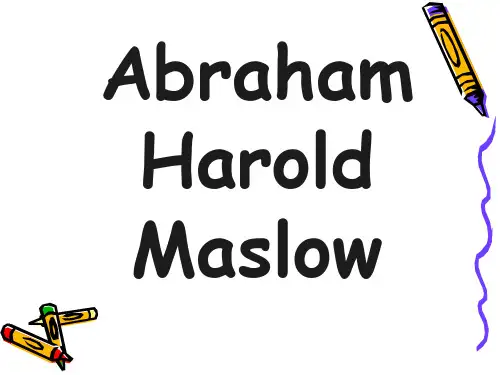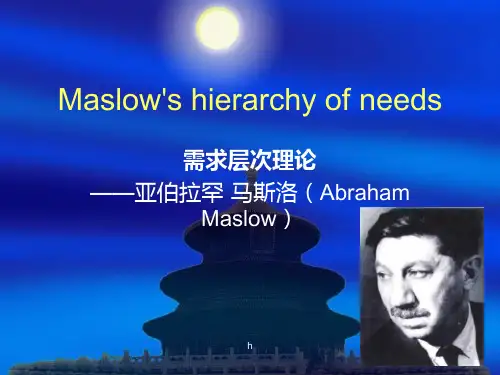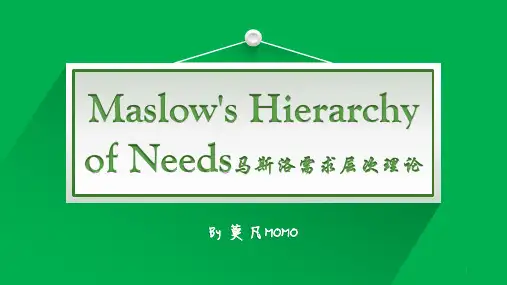马斯洛需求层次理论英文版PPT课件
- 格式:ppt
- 大小:1.34 MB
- 文档页数:13





![马斯洛需求层次理论英文版[优质ppt]](https://uimg.taocdn.com/0ceb158d65ce0508763213c9.webp)




Maslow's Hierarchy of NeedsBy 莫凡MOMO1目录 content010203Maslow and his hierarchy of needs PyramidDefining each needPros and consHierarchy of needs is a theory in psychology proposed by Abraham Maslow in his 1943 paper "A Theory of Human Motivation" in Psychological Review.Born Abraham Harold Maslow, 1908Brooklyn, New YorkDied , 1970 (aged 62), CaliforniaNationality AmericanFields PsychologyMaslow's hierarchy of needs belongs to motivational theory in psychology. Maslow said human has needs that need to be fulfill in a specific order.Maslow’s Hierarchy of Needs PyramidPhysiological 生理需要Safety 安全需要Love/belonging 社交需要Esteem 尊重需要 Self-actualization 自我实现Basic needsPsychological needsSelf-fulfillment needsPhysiological needs are the very basic needs such as air, water, food, sleep, sex, etc. When these are not satisfied we may feel sickness, irritation, pain, discomfort, etc.Safety needs have to do with establishing stability and consistency in a chaotic world including Security, Order, and Stability. People want control and order in their lives, so this need for safety and security contributes largely to behaviors at this level.Some of the basic security and safety needs include: Financial securityHeath and wellnessSafety against accidents and injuryThe third level of need is "Love and Belonging", which are psychological needs; when individuals have taken care of themselves physically, they are ready to share themselves with others, such as with family and friends.Some of the things that satisfy this need include: ●Friendships●Romantic attachments●Family●Social groups●Community groups●Churches and religious organizationsThe fourth level is achieved when individuals feel comfortable with what they have accomplished. This is the "Esteem" level, the need to be competent and recognized, such as through status and level of success.At the top of the pyramid, "Need for Self-actualization“.Basically our need for wanting morality, a need for acceptance and also creativity. So we can realize our full potential. Those who reach this level can seek knowledge, peace, esthetic experiences, self-fulfillment, etc.Ie: someone takes up environmental causes, join the Peace Corps,go off to a monastery, etc.Maslow’s Hierarchy of Needs Pyramidproperty,employment,resourcesConfidence,achivement,respect byothersMorality,creativity,achiving one’sfull potentialBreathing,food,water,sex,sleep Family,friendship,intimaterelationshipPhysiological 生理需要Safety 安全需要 Love/belonging 社交需要 Esteem 尊重需要 Self-actualization 自我实现IF there is one thing you can do to satisfy all five needs once and for all, what is it?Advantages•Offer perceptive insight into human nature•it can be easily grasped and applied.•There's an approximate correlation with stages of individual human development. Disadvantages•not empirically supported.;. Based on clinical observation, not on scientific research using large population samples.•fail to account for cultural or social differences between individuals.•Validity?See MORE for:●Maslow’s Hierarchy of Needs Theoryhttps://.au/toolbox/Tourism/tourismtoolbox /reslib/09/09_maslows_hierarchy_of_needs_theory.html●Maslow‘s hierarchy of needs from Wikipediahttps:///wiki/Maslow%27s_hierarchy_of_needs#R esearch●The Five Levels of Maslow's Hierarchy of Needshttps:///hierarchy-of-needs-2795947THANKS。

马斯诺需求理论Maslow's hierarchy of needsMaslow's hierarchy of needs is often portrayed in the shape of a pyramid, with the largest and most fundamental levels of needs at the bottom, and the need forself-actualization at the top.The most fundamental and basic four layers of the pyramid contain what Maslow called "deficiency needs": esteem, friendship and love, security, and physical needs. With the exception of the most fundamental physiological needs, if these "deficiency needs" are not met, the body gives no physical indication but the individual feels anxious and tense. Maslow's theory suggests that the most basic level of needs must be met before the individual will strongly desire (or focus motivation upon) the secondary or higher level needs. Maslow also coined the term Metamotivation to describe the motivation of people who go beyond the scope of the basic needs and strive for constant betterment.1. The physiological needs. For the most part, physiological needs are obvious —they are the literal requirements for human survival. If these requirements are not met, the human body simply cannot continue to function.2. The safety and security needs. When the physiological needs are largely taken care of, this second layer of needs comes into play. You will become increasingly interested in finding safe circumstances, stability, protection.3. The love and belonging needs. When physiological needs and safety needs are, by and large, taken care of, a third layer starts to show up. You begin to feel the need for friends, a sweetheart, children, affectionate relationships in general, even a sense of community. It is also a part of what we look for in a career.4. The esteem needs. Next, we begin to look for a little self-esteem. Maslow noted two versions of esteem needs, a lower one and a higher one. The lower one is the need for the respect of others, the need for status, fame, glory, recognition, attention, reputation, appreciation, dignity, even dominance. The higher form involves the need for self-respect, including such feelings as confidence, competence, achievement, mastery, independence, and freedom. Note that this is the “higher” form because, unlike the respect of others, once you have self-respect, it’s a lot harder to lose.5. The Self-actualization This level of need pertains to what a person's full potential is and realizing that potential. Maslow describes this desire as the desire to become more and more what one is, to become everything that one is capable of becoming. This is a broad definition of the need for self-actualization, but when applied to individuals the need is specific. As mentioned before, in order to reach aclear understanding of this level of need one must first not only achieve the previous needs, physiological, safety, love, and esteem, but master these needs。
Is Maslow’s hierarchy of needs theory applicable in today’ssocial work? And why?Maslow’s Hierarchy of Needs is a motivational theory in psychology that argues that while people aim to meet basic needs, they seek to meet successively higher needs in the form of a hierarchy. It is often portrayed in the shape of a pyramid. The lowest levels of the pyramid are made up of the most basic needs, while the more complex needs are located at the top of the pyramid. Maslow's theory suggests that the need for self-actualization, that is, the need that human beings have to realize their full potential, can only be fulfilled once other needs have been met. Self-actualization describes an inborn tendency for human beings to grow and to maximize innate talents and potentialities.According to Maslow, the first level includes basic physiological needs for food, shelter, clothing, and so on. Once these needs have been met, the actualization process creates a momentum for the next level of needs to be realized, namely, for security and safety and to feel free from danger. Again, once these have been met, there is an innate motivation to move on to the next stage, and so forth.Although Maslow’s concept is meaningful to our social work, there are still some criticisms. Some have noted vagueness in what is a “deficiency”; what is a deficiency for o ne is not necessarily a deficiency for another. Secondly, there seem to be various exceptions that frequentlyoccur. For example, some people often risk their own safety to rescue others from danger. In their extensive review of research based on Maslow's theory, Wahba and Brudwell found little evidence for the ranking of needs Maslow described or even for the existence of a definite hierarchy at all. Chilean economist and philosopher Manfred Max-Neef has also argued fundamental human needs are non-hierarchical and invariant in nature—part of the condition of being human; poverty, he argues, may result from any one of these needs being frustrated, denied or unfulfilledThe order in which the hierarchy is arranged has been criticized as being ethnocentric by Geert Hofstede. Hofstede's criticism of Maslow's pyramid as ethnocentric may stem from the fact that Maslow’s hierarchy of needs neglects to illustrate and expand upon the difference between the social and intellectual needs of those raised in individualistic societies and those raised in collectivist societies. Maslow created his hierarchy of needs from an individualistic perspective, being that he was from the United States, a highly individualistic nation. The needs and drives of those in individualistic societies tend to be more self-centered than those in collectivist societies, focusing on improvement of the self, with self actualization being the apex of self improvement. Since the hierarchy was written from the perspective of an individualist, the order of needs in the hierarchy with self actualization at the top is not representative of theneeds of those in collectivist cultures. In collectivist societies, the needs of acceptance and community will outweigh the needs for freedom and individuality.Maslow’s hierarchy has also been criticized as being individualistic because of the position and value of sex on the pyramid. Maslow’s pyramid puts sex on the bottom rung of physiological needs, along with breathing and food. It views sex from an individualistic and not collectivist perspective. This view of sex neglects the emotional, familial and evolutionary implications of sex within the community.As Hayes said, Maslow’s model may provide a rough w orking generalization about most people in most situations, but it is not really adequate as an explanation of human motivation.It seems that a lot of social work principles are based on this pyramid; I would argue that most of the other helping professions only work at the top three rungs of the pyramid. Social workers often find themselves starting at the bottom two.While Maslow’s theory is useful, it is of course an oversimplification of real life, especially when you consider that a lot of human beings would rearrange this pyramid in one way or another. For example, a lot of people may feel that this pyramid should be arranged with self-esteem as the bottom rung. They may feel that once a person has achieved a modicum of self esteem, that everything else will fall intoplace, including the ability to take care of basic needs. I agree with that in principle.But a large percentage of social work stops at the bottom two rungs, with the remainder being taken care of by a referral to a professional who handles those parts of the pyramid.The question is what we can do as social workers to encourage a client to move up the pyramid. For example, a lot of people at the shelter do indeed stop at the first two rungs; they get stuck in a cycle in which they do leave the shelter either by being kicked out or getting assisted with housing, but somehow end up back at the bottom of the pyramid again. For whatever reason, is it trauma, poor life skills in general, or a bad example while growing up, they never can seem to get out of this cycle. And ethically, we can’t force them to.Is it a dependency issue, that is, do they prefer to be in this cycle? Or are their mental health issues so severe that they just can’t get out of the cycle? If so, why are there not better resources for handling these issues? It seems to not make any sense to provide for just the basic needs and stop there. The goal should be to allow clients to move farther up the pyramid, and to have the resources to do that. If not, our society is just perpetuating the problem by creating dependency when it comes to a person’s basic needs.So in social work we often encounter situations where if appearsvery difficult for some individuals to move their lives forward beyond the first two levels. The energy spent on trying to survive in the face of adversity necessarily means that emotional resources or energy are not free to be used on other courses of action, such as finding a job, sorting out school problems or meeting other needs. This has important implications for our work because it could mean that providing the right kind of practical or material assistance, or emotional support for service users, could release the momentum and motivation towards self-sufficiency and independence. Without this understanding, we run the risk of providing resources and services into a bottomless pit, where fundamental change does not happen.To conclude, although this theory has serious limitations, there is no doubt that Maslow’s hierarchy of needs theory is still applicable in today’s social work. I think what our social worker should do is to understanding this theory well and try our best to adapt it into our daily work. There must be a wide gap between theory and practical operation, which need us to consummate and find the balance through our experience.。